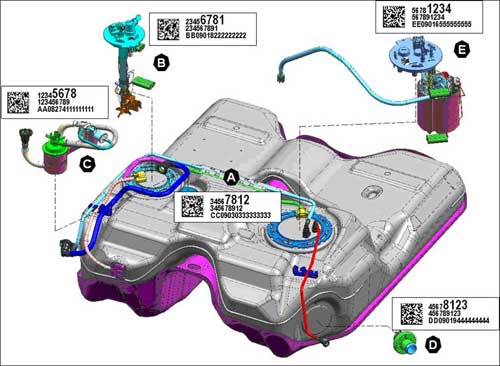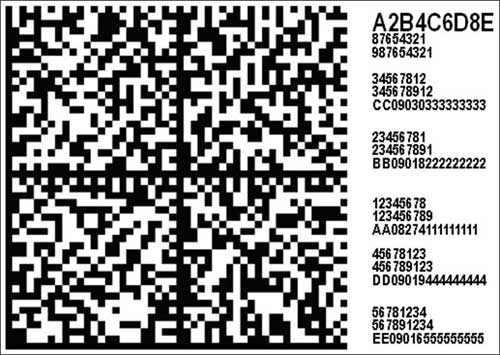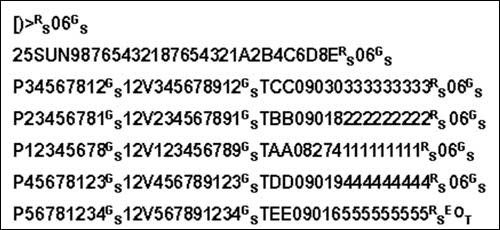Most readers of RFID Journal know that RFID stands for radio frequency identification, and that the technology is used, among other functions, to track things—kind of like electronic bar codes. However, most reported implementations only utilize the most basic feature of the technology—the unique identification (UII) number, or birth record. Although standards are intended to enable the use of technology, perhaps the large number of standards is actually an impediment to the broad use of RFID’s full capability.
It need not be so. One standard, in particular, now exists that attempts to illustrate, through examples, how to implement the proper coding of information beyond a simple ID into an RFID tag’s memory: the just-released B-11 Revision 8 Item-Level RFID standard, developed by the Automotive Industry Action Group (AIAG), a nonprofit organization whose 500-plus company membership includes Caterpillar, Chrysler Group LLC, Daimler, Ford Motor Co., General Motors Co., Honda, Navistar International, Nissan, Toyota and many of these companies’ parts suppliers and service providers.
|
|
Standards—What Good Are They?
Doing things according to standards—or accepted rules of conduct (behavior)—is critical for everyday life. Without adherence to these norms, automobile traffic flow through intersections could be deadly, and people wouldn’t be able to communicate using telephones, faxes or the Internet.
Specific to this article, the accepted rules of conduct for RFID are embodied in such standards as ISO/IEC 18000-6 Type C, EPCglobal Gen 2 UHF, ISO/IEC 15961, ISO/IEC 15962, EPCglobal TDS 1.5, ISO 1736x and numerous others (see the Reference Section of the Automotive Industry Action Group’s B-11 Revision 8).
The Problem
This partial list of relevant standards illustrates what is perceived as the problem—there are many standards, and they can be very difficult to comprehend. It is especially difficult for those who are not RFID experts. Trying to sort through, decipher and understand the content of all of these standards—and then to implement them—can be very daunting.
The Solution
The purpose of B-11 Rev 8 is to enable those who don’t want to become experts in a new technology to still be able to use it, and to understand it at a high level without having to master the nitty-gritty.
RFID Applications—Closed-loop / Limited Application
RFID Journal regularly documents various RFID implementations taking place around the globe. A close examination of these examples would yield two general observations.
The first observation is that most of these programs are closed-loop systems, operating either within a single organization or between two parties. Closed-loop in this context means that the information being carried by the RFID tag is retained, and has meaning only within the company or organization implementing the RFID system. Such systems can be implemented without complying with any standard regarding data format or the meaning of such information. Those who implement the system know how to encode and decode the data in a tag, and that data only has meaning to those specific entities.
An example of a two-party closed system is a single supplier providing products to a single customer. In this case, as long as those two parties know the methods of putting bits into and taking bits out of a tag’s memory, and they have agreed to what those bits mean, the system works well. But a third party attempting to read data on one of these tags would be clueless as to what any of those bits mean.
The second observation is that most RFID implementations overwhelmingly place onto the tag and use only one piece of data. That single bit of information is the unique item identification (UII) number, or the “name” of the tagged item. These implementations do not make use of a powerful capability of RFID—the ability to store additional information on a tag beyond just the UII. While utilizing just the UII can be effective, there are numerous instances—and, in fact, entire industries—in which the use of additional data on a tag provides considerably more value. In some cases, this additional data provides the cost-benefit tipping point for using RFID.
For an application that utilizes the additional data-carrying capability of RFID—and one that must function in an open-loop or multi-party system—it is vital that it conform to relevant and published standards. Only by adhering to the standards’ rules can a conforming tag be encoded and read, and the tag’s data be understood globally.
RFID Application—Open-loop / Full-featured
The automotive original equipment manufacturing (OEM) industry has, for many decades, routinely exchanged parts and data through multiple parties and several levels within a supply chain. Today, identifying and tracking all of these parts—in real or near-real time—is a monumental task, and various means of automatic identification are currently employed. RFID is among them, and is being used precisely for two reasons:
• It can provide more than a simple name for an object.
• The additional data in memory can be changed during the part’s lifespan.
One of the biggest stumbling blocks to widespread RFID implementation appears to be not only identifying which RFID standards are relevant, but also understanding those standards well enough to be able to implement them. The good news is that the International Organization for Standardization (ISO) and EPCglobal have effective RFID standards. The better news is that they work well together. In fact, in critical areas, relevant portions of these standards are identical!
The bad news is that they are very difficult to comprehend and then implement, especially for those non-subject-matter experts (the majority of the world) looking to implement RFID for more than just a small pilot. Most organizations that want to employ RFID do not have the requisite knowledge. Ideally, they would like to purchase what they need, and then be off and running. Unfortunately, the supplier base is not quite yet at that level, so those organizations that want or need to delve deeper into the technology—and then implement it—must struggle to understand the standards on their own.
The AIAG has successfully created effective, implementable standards for more than 25 years. The B-11 Revision 8 standard provides detailed, easy-to-understand explanations, with examples, of the relevant parts of the ISO and EPCglobal standards required to implement full-function RFID identification and tag-data storage systems.
The overall goal of B-11 Rev 8 is to show that common data needs (unique item identity, plus additional data about that item) can be satisfied using globally applicable data syntax and implementation standards—regardless of what is carrying the information.
AIAG B-11 Rev 8
Automatic identification and data collection (AIDC) technologies have been critical to the automotive industry’s day-to-day processes for many years. These technologies include linear bar codes (Code 39, Code 128), two-dimensional symbologies (QR, Data Matrix), direct part marking (engraving, etching and peening) and RFID.
One critical factor in successful RFID implementations is to make its use transparent with respect to the above-mentioned AIDC methods. The goal is to make the data the important part, and to make the data carrier device irrelevant, whether it’s a bar code or RFID tag. To do this, a standard way of creating the information and putting it on the data carrier is needed—one song, with everybody knowing the notes, but playing them on different instruments.
The B-11 Item-Level RFID Standard was created in 2001 as a solution to one very specific problem—namely, how to track tires. Since 2001, with global input, B-11 has grown to cover not only tires, but any item or object. Revision 8 of the standard explains the global answer to a global question: How do we use RFID to carry data interchangeably and seamlessly with other AIDC methods?
Specifics
There are four data blocks on an ISO/IEC 18000-6 Type C / UHF EPC Gen 2 RFID tag: MB00, MB01, MB10 and MB11. (The numbers are actually binary numbers and are usually followed by a subscript 2; MB00 is the first memory block, and MB11 is the fourth memory block.) To maximize the benefits, there are two data blocks that need to be used together when storing various data elements: the Unique Item Identification Memory Block (MB01, the second memory block) and the User Memory Block (MB11, the fourth memory block).
An item’s unique item identification, or name, is placed into MB01. Additional data about that item is placed into MB11 (see Tag Memory Banks—MB01 and MB11).
The ISO and EPCglobal RFID standards have very precise rules for creating the UII that would be placed into MB01. They are unambiguous, each method resulting in a unique name. They are also complex. In the case of EPCglobal-based structures, any of the identity types as described in the published TDS 1.4 or draft TDS 1.5 could be used as a name. For ISO-based structures, the use of the data identifier “25S” as the name serves the same purpose. The B-11 Rev 8 standard contains details on and examples of both schemes.
There are also several methodologies of encoding the additional data into MB11, outlined in the ISO and EPCglobal standards. Again, B-11 Rev 8 provides details and examples.
One example is a gas tank use-case that was pulled from the B-11 Rev 8 standard. It is a real example of how information can be stored on a 2D Data Matrix symbol or an RFID tag, while maintaining the data’s syntax.
Note: The details provided in this example are highlights of the actual data-handling process. This example is provided as an overview to aid in understanding, and is not intended to be fully descriptive. The actual data shown is not real.
Figure 1: Components of a Gas Tank—”As Built'” Example
As can be seen in Figure 1, there are at least five subassemblies that go into making a gas tank. These subassemblies are identified A through E, and include items like vents and filters, as well as level indicators.
The process of creating a unique name starts at the point where the individual item (in this example, the filter, vent, pump, sensor or gas tank) is created. Each subassembly label carries its own data elements: its unique item identification number (name), part number, supplier and serial number.
The following 2D symbol has each of these subassemblies’ discrete data elements encoded within it, plus one unique identity for the entire, assembled gas tank. This data migration also shows the child-to-parent relationship, and is applicable regardless of what is carrying the data. (Note: The 2D symbol is not displayed to scale.)
Figure 2: “As Built” 2-D Symbol
Shown below is the data encoded within the 2-D symbol above. The data was separated into lines and spaces for human readability; they are not encoded in the data.
Figure 3: Data Encoded Within the “As Built” 2-D Data Matrix
The data, as represented in Figure 3, would be placed into an RFID tag as follows:
• The first line of data is called the message header, and tells the decoder (either bar-code or RFID) that the data following is constructed according to the rules of the ISO 15434 standard, which specifies the structure, syntax and coding of messages and data.
• The second line is the completely assembled gas tank’s Unique Item Identification number, and will be placed into MB01 of the RFID tag as this gas tank’s birth record (UII).
• The third through seventh lines provide information regarding each individual subassembly of the gas tank, and will be placed into MB11 of the RFID tag as additional information about that gas tank. They represent the subassembly’s part number (P), its manufacturer (12V) and its traceability code (T).
• The EOT at the end of the data indicates the end of the overall message.
Whether the data comes from a bar code or an RFID tag, it will be the same.
RFID Is Here Today!
The AIAG B-11 Rev 8 standard was created to provide easy-to-understand guidance on a difficult subject, through unambiguous explanations and examples. While there are many different RFID standards that need to be understood, the detailed examples contained within the B-11 provide guidance that can assist in enabling and easing future RFID implementations.
There is now no reason why radio frequency identification cannot be rolled out to the global using-community in open-system, standards-based, multi-partner supply chains. Revision 8 of the AIAG B-11 Item-Level RFID standard, published on Nov. 16, can be obtained by contacting AIAG at (248) 358-3303, or by visiting the group’s Web site, www.aiag.org.
Bill Hoffman is the founder and president of Hoffman Systems LLC, a bar-code and RFID consultancy and systems integrator, and standards support company.
Paul Wilson, an engineer for Bridgestone Americas Tire Operations LLC, Fangming Gu, a researcher at General Motors Co. and Patrick King, leader for global electronics strategies at Michelin Americas Research Corp. (a unit of Michelin North America Inc.), contributed to this article.
Tag Memory Banks—MB01 and MB11
By Paul Wilson
The RFID tag being discussed is one that complies with the ISO/IEC 18000-6C / EPCglobal UHF Gen 2 air interface protocol. Such tags have four memory banks, two of which store a user’s data on the tag. These two locations are technically referred to as memory banks 01 and 11, often abbreviated as MB01 and MB11 (pronounced “em bee zero one” and “em bee one one”). The size of MB01 is usually very limited; its sole purpose is to contain the name by which the tag (as well as the item to which it is associated) is known. MB11’s capacity is generally much larger, and is the place where all additional user-defined data will be stored.
Memory Bank 01—The “Name”
Memory Bank 01 contains the information referred to as the Unique Item Identification (UII) number. This piece of data is created at the time that the tag is placed onto an item, and can be thought of as that item’s birth record, or name. This name must be unique in the world. This uniqueness is one of the desirable features of RFID technology, and is assured if one correctly follows the published standards. Once this UII has been created and written into MB01, there is great benefit in locking this data to prevent future changes. Locking the UII data in MB01 will not affect user data that may be written into MB11.
The organization that places a tag onto an item has the responsibility of creating the UII and ensuring that it is a unique name. Various standards organizations have defined rules for not only creating the name, but making it unique in the world—if the rules are strictly followed.
Memory Bank 11—The “Data”
Memory Bank 11 is also called the user data memory bank, and the information it contains will be referred to here simply as the data. As is possible for any -6C memory bank (that isn’t locked), information placed into this memory location can be written, read and rewritten. There are a number of methods available for encoding and decoding the data bits comprising the information placed into MB11. A straightforward method that is most easily understood by many is described in the accompanying article. This method is recommended because of its simplicity, and is the only method described in detail. However, other methods for encoding data are available, and are listed in the B-11 document. Hardware or software vendors may employ any and all of those methods, which should all be compatible and interchangeable.
As declared by the AIAG B-11 standard, all of the data stored within MB11 must include a data identifier for each data item. Internationally accepted data identifiers can be found on a list maintained by AutoID.org (click here to view the list).
Should the need arise for a new data identifier, the MH10.8.2 document found at the above link contains a request form and procedure for creating a new data identifier to meet the needs indicated by the requestor. Using these published data identifiers will enable reader and software vendors to create applications that can read tag data and decipher its meaning. This is absolutely necessary for true open-loop RFID applications.
Paul Wilson is an engineer for Bridgestone Americas Tire Operations LLC.





